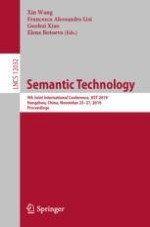2020 | Buch
Semantic Technology
9th Joint International Conference, JIST 2019, Hangzhou, China, November 25–27, 2019, Proceedings
herausgegeben von: Xin Wang, Dr. Francesca Alessandra Lisi, Guohui Xiao, Dr. Elena Botoeva
Verlag: Springer International Publishing
Buchreihe : Lecture Notes in Computer Science
